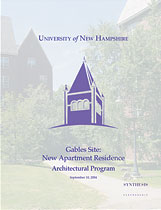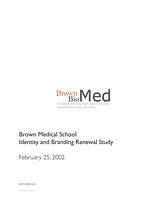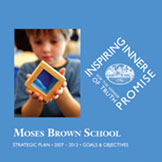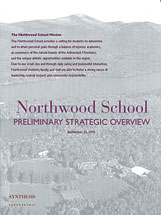Synthesis Partnership
683 Commonwealth Avenue
Newton Massachusetts 02459
617 340 9991
[email protected]
Aligning strategy,
identity, capacity, and facilities
with mission, vision, and values.
© 2019 Synthesis Partnership
All rights reserved
Education
University of New Hampshire
Durham NH
Facilities Identity

As it completed a new campus master plan and approached an opportunity for a new round of project funding, the University identified three residential projects to be developed to accommodate 980 beds. The University previously had done minimal programming and budgeting before requesting project funding. This often led to difficulties when subsequent project definition identified additional costs, which then had to be accommodated by compensatory cuts.
To correct this problem, the University retained Synthesis Partnership to conduct a comprehensive process of preparation to develop a thorough grounding for the projects and a clear and reliable budget. A secondary goal for this assignment was to develop procedures, approaches, forms and reports to serve the University as a template for future planning and programming.
The projects all came in at the midpoint of our projected budget range. The University later used our work to plan additional residential space on its own, and asked Synthesis Partnership back for subsequent projects.
The scope of work included:
- Site assessment
- Architectural programming
- Comprehensive project budgeting
- Oversight and coordination of the work of technical consultants
Brown Medical School
Providence RI
Strategy Identity

The Office of Advancement of Brown Medical School asked Synthesis Partnership to assist in the development of the School’s identity and branding strategy, which was deemed fundamental to an effective launch of a new name (and accompanying positioning) of the school. We built our study on the premise that the ultimate goal of naming, positioning and identity is to establish mind-share among prospective and current students; residents, faculty, and alumni; and the public (consumers, voters and donors)—all essential contributors to the success of the school’s mission, and all of whom have many competing draws on their attention. We conducted in-person and telephone interviews among various constituencies, and e-mailed a set of open-ended questions to others.
Our research and observations resulted in recommendations in four primary areas:
- Clarifying the product (simplify message, increase focus on primary assets, commit to benchmarking and strategic planning for longer term solutions).
- Marketing the school (determine target audiences and overhaul the Website to focus on user-centered objectives, not data-centered capabilities)
- Increasing visibility in the community (invest in a more robust communications strategy, identify and consolidate physical presence)
- Graphic representation of identity (create and use a consistent institutional mark both linking to the university and differentiating from it)
Franklin Pierce Law Center
Concord NH
Strategy Identity Facilities
Pierce Law Center was an independent law school, highly ranked in its specialty of intellectual property law. Pierce Law faced the need to examine a range of critical issues, including its independent status (it subsequently became part of the University of New Hampshire), location, relationship to the profession in New Hampshire, and competitiveness both in its field of specialization and in its recruitment of students and faculty. Pierce Law asked Synthesis Partnership to develop and guide a strategic planning process, and to coordinate with issues raised during a concurrent process of a faculty-based self-study for re-accreditation.
St. George’s Independent School
Memphis TN
Strategy Identity Capacity

St. George’s Independent School was a suburban Episcopal lower school until the mid 1990s. The board of trustees decided to expand by adding both a middle/high school and a second, inner city, lower school. The vision of the board was to nurture an inner city population receiving substantial scholarship assistance and join it with a typical suburban independent school population, creating a single community.
Once the new campuses were in place, the need became clear for a long range plan to guide growth and the melding of three campuses—and two very different communities—together as one school. St. George’s retained Synthesis Partnership to guide the planning process. Synthesis Partnership provided expertise and guidance to staff and board leadership, and to the planning committee and its subcommittees. We planned and facilitated two retreats, conducted surveys to identify concerns and clarify perceptions, and shaped the final plan.
Moses Brown School
Providence RI
Strategy Identity Capacity

The Board of Overseers of Moses Brown School retained Synthesis Partnership to guide a strategic planning process, in part to address some specific issues, but largely to pull the school’s constituencies together into a productive discussion. The board and the faculty engaged in separate processes of strategic and academic planning. Through surveys of current parents, alumni, parents of alumni, faculty and students, and focus groups with parents, much was learned about varying perspectives on and levels of understanding of the school and its mission. The process identified areas where parents and alumni needed to be better informed, and the perceptions from parents were helpful in offering the faculty new insights about their own work.
The Quaker commitment to consensus did not slow down the planning process, which was completed on schedule. Instead, it reinforced the Synthesis Partnership definition of strategic planning: the development, through inclusive engagement of all constituencies, of awareness and consensus around mission. In one sign of effective consensus, the mission statement was reduced from 137 words to a powerful, compelling, and memorable 24 words. The new statement encapsulates the mission of the school and focuses attention on the essence of the school’s commitment to its community.
The International School of Boston
Cambridge MA
Strategy Identity Capacity Facilities
Over a period of six years we worked with the International School of Boston (under three different heads) twice on strategic and business planning, twice on board and organizational development once on academic planning and once on facility planning. Through documentation, benchmarking, analysis, interviews, facilitated meetings, surveys, and written reports, Synthesis Partnership helped the board to understand its options and framed them in a way that encouraged broader discussion.
The Lamplighter School
Dallas TX
Strategy Identity Capacity Facilities
We were asked by a new Head of School to assist this independent early childhood and elementary school in developing strategic and academic plans. We worked with a very experienced board, and with staff who were largely new to planning, to lay the groundwork for a renewal of the vision for the school, including a new mission statement. Later we were asked to introduce the board to the intricacies of a facility planning process.
Northwood School
Lake Placid NY
Strategy Identity Capacity

Over the course of sixteen years Synthesis Partnership advised Northwood School in strategy, planning and board governance. Our first assignment was to conduct a study of the school’s situation, issues, resources, and needs. We identified and analyzed several interrelated critical areas in which the school needed to improve its performance to compete effectively, especially in the vital cycle of student retention, alumni loyalty, alumni giving, financial aid, and student recruitment. Our findings guided the governing board in developing their understanding of the school and its competitive context. Subsequently we guided the school through three strategic plans, several independent surveys, and two further rounds of board self-assessment.
The Wheeler School
Providence RI
Strategy Identity Capacity Facilities

The Wheeler School had almost doubled in size since its transformation in the late 1970s from a girls’ boarding school to a co-educational day school, but the physical plant had grown only modestly. The Board of Trustees approved a capital campaign, but found there were too many variables for them to approach critical decisions with the prudence they wished. Synthesis Partnership was retained to guide the planning process. Over the course of several projects over twelve years, we:
- designed a transparent planning process with an action-oriented agenda (which gradually became a comprehensive Ten-Year Plan)
- examined the physical plant, maintenance budget, space needs, and program objectives, and framed capital expenditures in terms of institutional goals
- developed an architectural program and budget for several projects
- developed a business plan for non-tuition revenue programs that would draw on and contribute to the school’s brand
- created a financial model that showed how non-tuition revenue could expand the capacity of a capital campaign
- guided the selection and oversight of architects and landscape architects
- created a master plan for the school’s 120-acre farm
- established working procedures that continued to function after their initial goals were achieved,
- guided a campus master planning process